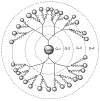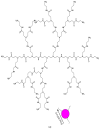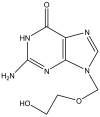Application of Dendrimers for the Treatment of Infectious Diseases
- PMID: 30200314
- PMCID: PMC6225509
- DOI: 10.3390/molecules23092205
Application of Dendrimers for the Treatment of Infectious Diseases
Abstract
Dendrimers are drug delivery systems that are characterized by a three-dimensional, star-shaped, branched macromolecular network. They possess ideal properties such as low polydispersity index, biocompatibility and good water solubility. They are made up of the interior and the exterior layers. The exterior layer consists of functional groups that are useful for conjugation of drugs and targeting moieties. The interior layer exhibits improved drug encapsulation efficiency, reduced drug toxicity, and controlled release mechanisms. These unique properties make them useful for drug delivery. Dendrimers have attracted considerable attention as drug delivery system for the treatment of infectious diseases. The treatment of infectious diseases is hampered severely by drug resistance. Several properties of dendrimers such as their ability to overcome drug resistance, toxicity and control the release mechanism of the encapsulated drugs make them ideal systems for the treatment of infectious disease. The aim of this review is to discuss the potentials of dendrimers for the treatment of viral and parasitic infections.
Keywords: antivirals; dendrimers; drug delivery; parasites; polymers.
Conflict of interest statement
The authors declare no conflict of interest.
Figures



















Similar articles
-
Dendrimers--revolutionary drugs for infectious diseases.Wiley Interdiscip Rev Nanomed Nanobiotechnol. 2012 Sep-Oct;4(5):469-91. doi: 10.1002/wnan.1181. Epub 2012 Jul 3. Wiley Interdiscip Rev Nanomed Nanobiotechnol. 2012. PMID: 22761054 Review.
-
Dendrimers as drug carriers: applications in different routes of drug administration.J Pharm Sci. 2008 Jan;97(1):123-43. doi: 10.1002/jps.21079. J Pharm Sci. 2008. PMID: 17721949 Review.
-
Application of dendrimer-drug complexation in the enhancement of drug solubility and bioavailability.Expert Opin Drug Metab Toxicol. 2008 Aug;4(8):1035-52. doi: 10.1517/17425255.4.8.1035. Expert Opin Drug Metab Toxicol. 2008. PMID: 18680439 Review.
-
Polymeric therapeutic delivery systems for the treatment of infectious diseases.Ther Deliv. 2017 Jul;8(7):557-576. doi: 10.4155/tde-2017-0008. Ther Deliv. 2017. PMID: 28633590 Review.
-
Developments in Treatment Methodologies Using Dendrimers for Infectious Diseases.Molecules. 2021 May 31;26(11):3304. doi: 10.3390/molecules26113304. Molecules. 2021. PMID: 34072765 Free PMC article. Review.
Cited by
-
A Molecular Dynamics Simulation of Complexes of Fullerenes and Lysine-Based Peptide Dendrimers with and without Glycine Spacers.Int J Mol Sci. 2024 Jan 5;25(2):691. doi: 10.3390/ijms25020691. Int J Mol Sci. 2024. PMID: 38255765 Free PMC article.
-
In vitro and ex vivo protoscolicidal effect of poly(amidoamine) nanoemulsion against Echinococcus granulosus.Sci Rep. 2024 May 25;14(1):11957. doi: 10.1038/s41598-024-62015-0. Sci Rep. 2024. PMID: 38796499 Free PMC article.
-
Structural Characterization of Biomaterials by Means of Small Angle X-rays and Neutron Scattering (SAXS and SANS), and Light Scattering Experiments.Molecules. 2020 Nov 29;25(23):5624. doi: 10.3390/molecules25235624. Molecules. 2020. PMID: 33260426 Free PMC article. Review.
-
Emergence of Small Interfering RNA-Based Gene Drugs for Various Diseases.ACS Omega. 2023 Jun 1;8(23):20234-20250. doi: 10.1021/acsomega.3c01703. eCollection 2023 Jun 13. ACS Omega. 2023. PMID: 37323391 Free PMC article. Review.
-
From Bench to the Clinic: The Path to Translation of Nanotechnology-Enabled mRNA SARS-CoV-2 Vaccines.Nanomicro Lett. 2022 Jan 3;14(1):41. doi: 10.1007/s40820-021-00771-8. Nanomicro Lett. 2022. PMID: 34981278 Free PMC article. Review.
References
-
- Brownlie J., Peckham C., Waage J., Woolhouse M., Catherine Lyall C., Meagher L., Tait J., Baylis M., Nicoll A. Infectious Diseases: Preparing for the Future—Future Threats. Office of Science and Innovation; London, UK: 2006. - PubMed
-
- National Institutes of Health (US) Understanding Emerging and Re-emerging Infectious Diseases. [(accessed on 30 December 2016)];2007 Available online: https://www.ncbi.nlm.nih.gov/books/NBK20370/
Publication types
MeSH terms
Substances
LinkOut - more resources
Full Text Sources
Other Literature Sources
Medical

